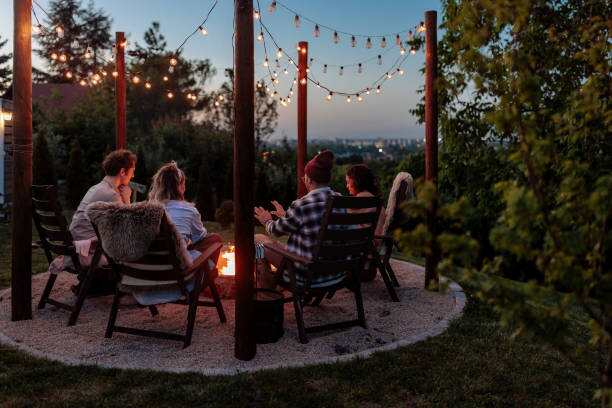Designing a backyard that is not prone to fire hazards is important during dry seasons when wildfires as well as accidental fires can spread within a short time.
Residents of these areas need to think thoroughly about how they use their outdoors areas to minimize the risks and still be functional and attractive. Creating a fire-resistant backyard is a result of planning the landscaping, selecting materials, and proper location of constructions. The careful planning can make it possible to use the beautiful and safe outdoor space even in the regions where dryness and hot temperatures are possible.
Assessing The Backyard For Fire Risks
Assessment of the possible risks is the first step towards constructing a fire resistant backyard. Fires can be fed on by dry grass, thickly spaced shrubs and trees hanging over them. It is also important to examine the location of the current structures, such as the house and any sheds, to make sure that not too many combustible materials are nearby the possible areas of ignition. The areas that can be found to be more vulnerable can enable homeowners to strategize on precautionary measures and minimize chances of fire propagating in the home.
Planning A Fire-Safe Layout
A fire-safe backyard must be carefully designed so that the potential sources of ignition are separated with the areas vulnerable to do not come into contact. The establishment of open spaces in and about homesteads as well as other buildings curbs the propagation of fire. Think about creating routes and interplanting to create natural fire breaks. The layout must also be easy to access in the event that emergency personnel may be required to access the property in a prime time. With adequate planning, the backyard can be arranged in such a way that it is safe and at the same time practical in terms of use.
Planning Fire-Resistant Plants
Fire resistant landscaping involves the correct choice of plants. Species of high moisture content, native and drought tolerant are better since they are less likely to ignite. Plants that are highly flammable like pines, eucalyptus and some ornamental grasses should be avoided. Plants which require the same amount of water are put together in groups to ensure healthy growth and less stress that also contributes to resistance to fire. Considerate landscaping reduces the consumption of fuel to burn the plants, and the natural beauty of the backyard is retained.
Non-Combustible Hardscaping Materials
The use of non-combustible materials in walkways, patios and sitting areas can greatly increase fire resistance. Stone, concrete, brick, or gravel do not ignite and will act as a buffer to more flammable regions. Flammable surfaces around seating or entertainment space can also be minimized by installing such features as a privacy deck railing constructed of metal or treated materials. Hardscaping is functional in addition to its protective value in fire prone areas.
Safe Spacing Of Structures
Adequate interspacing of structures, fences and trees is also a very important element of fire safety. A privacy fence panel made of non-combustible materials could assist in creating a barrier but minimises the chances of the flames spreading around the yard. Trees are to be trimmed in order to avoid the overgrown branches, which can be burnt and fired to the surrounding buildings. The presence of clear areas in between the combustible buildings will mean any fire outbreak is less likely to grow out.
Lawn And Garden Maintenance
It is also important to do regular maintenance to maintain a fire-resistant backyard. Fall leaves and dead grass and branches may form tinder provided they are not controlled. This can be done by a regular mowing of the lawn, raking up debris and picking up dead vegetation that will supply the fuel needed to set fire. The type of mulch used must be well considered and gravel or stone should be used instead of highly inflammable material. Regular maintenance helps to make sure the fire resistance of the backyard is active in the long run.
Developing Firebreaks And Defensible Zones
Firebreaks can be developed in the backyard to limit or stop the outbreak of the fire. Firebreaks may consist of gravel routes, stone edging or low maintenance lawns. The home owners and emergency responders can better deal with fires by creating defensible areas around the house with less vegetation and non-combustible materials. The use of both natural and artificial firebreaks enhances the overall safety of the place, but does not harm the aesthetic value of the backyard.
Installation Of Fire Resistant Outdoor Buildings
Fire resistant materials should be used to build any other outdoor structures like sheds, gazebos, or pergolas. Flammability can be reduced by using metal, concrete or specially treated wood. The roof materials used should also be taken into consideration as some of the composite or shingles are more impervious to embers. Making sure that the outdoor constructions follow the fire-resistant principles will be part of the overall safety strategy of the backyard.
Water Supply And Fire Tools
Convenient water supply and the equipment used in fighting fire in the backyard is a sensible precaution. Hose connections, water tanks or strategically positioned sprinklers would in case of a fire be invaluable. The minimum equipment (fire extinguishers and simple equipment, such as rakes or shovels) will enable one to respond promptly in case of sparks. The ability to contain small fires before it deteriorates into a hazardous circumstance can be achieved by readily available resources that can reinforce the fire resistance of the backyard.
Electrical Safety Lighting And Outdoor
Electrical components like outdoor lighting, power points, and wiring might become a fire hazard when they have not been installed properly. Make sure that all outdoor electrical systems are of a safe standard and that they are not exposed to the weather. By applying fire-resistant enclosures and proper positioning, there are fewer chances of sparks causing fire to dry materials. Integrating electrical safety with fire resistant landscaping and buildings enhances the overall safety of the backyard.
Preparing To Change Seasons
Dry climates also tend to have seasonal changes which affect fire hazard. Low humidity and summer heat raise the risk of ignition, whereas rains at times can decrease them. The preparation against these season changes could entail regulating the irrigation, cleaning up the debris and firebreaks in the run-up to the most intense fire seasons. By being prepared early enough, the backyard will be safe all year round regardless of the weather conditions.
Conclusion
The construction of a fire-resistant back yard needs to be planned, landscaped with care and strategic materials in dry climates. Home owners can make their backyard safe and fun by evaluating the risks, using fire-resistant plants, and using hardscaping made of non-combustible materials. The space maintenance, frequent yard maintenance, and availability of water also contribute to an increase in fire safety. Such details as the integration of a privacy fence panel or a privacy deck railing consisting of fire-resistance materials can offer extra protection without sacrificing the beauty. Through a holistic strategy, one can have a beautiful outdoor area and maintain safety in fire prone places.



















